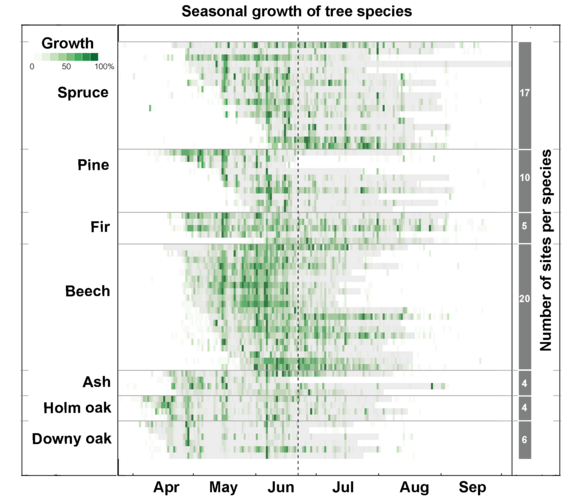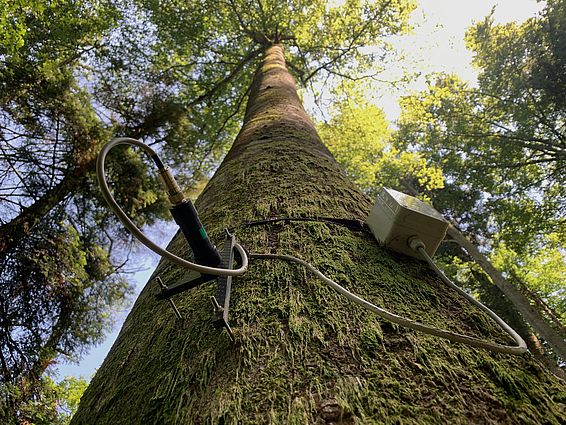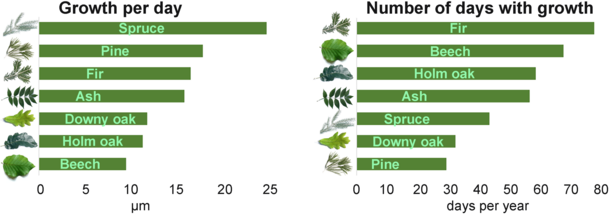Dec. 9, 2021 | Roman Zweifel, Sophie Etzold, Michèle Kaennel Dobbertin | News WSL
Rising temperatures extend the growing season in our latitudes, which could theoretically have a positive effect on forest growth. However, a study led by the Swiss Federal Research Institute WSL now shows that trees only grow on a few days at all. Warmer days in spring and fall can thus hardly contribute to wood formation, which is important for the future carbon sink capacity of forests.
Understanding how trees grow in relation to temperature, water availability and light conditions is crucial to improving predictions of the carbon sink capacity of forests. In a novel study published in the journal Ecology Letters, WSL researchers and their international co-authors went a step further and quantified not only how, but also when and why trees grow within a year.
They used daily growth data that were automatically measured for eight years on 160 trees at 47 sites across Switzerland. All seven tree species formed new wood cells on surprisingly few days. In general, trees grew increasingly fast in spring, with peak growth in April to June and a mostly sharp decline just before the summer solstice. The study explored the question of why the number of days with growth is so small.
The growth performance of a tree depends on just a few days ¶
The results show that only a small part of the vegetation period (12% to 30%) is actually used for annual growth: of the 365 days of the year, about 250 days count as the vegetation period, and of these again 90-120 days are possible days with growth. However, the data showed that the trees actually grew even less frequently.
"It was astonishing that all seven tree species grew on average on only 29 to 77 days per year," comments Sophia Etzold, a biologist at WSL in Birmensdorf and lead author of the study. Silver fir grew the most days per year, pine the fewest. Spruce, on the other hand, recorded the highest daily growth rates (25 µm/day), but only achieved 43 days with growth per year on average.
A longer growing season does not mean more growth ¶

The greater the wood increment, the more carbon a tree is able to sequester from the air. The novel study shows that the length of the growth period hardly plays a role, and that an early growth start before April, as well as a late end after October, even tend to lead to less annual growth. "This is an important finding in the context of rising CO2 concentrations and global warming," emphasises Roman Zweifel, head of the TreeNet measuring network, from which the data originate. Global warming has indeed extended the vegetation period, in which sufficient growing conditions prevail for trees in temperate zones. However, this advantage cannot compensate for the negative impacts of heat and drought during the actual growing months of April to June.
Day length and humidity determine whether growth takes place ¶
There is much evidence to suggest that trees in temperate zones follow an internal clock that reduces growth from around the summer solstice (June 21), even when external conditions are still good. "We assume that the decreasing day length acts as a signal for trees to complete radial increment and give priority to other processes (e.g., lignification of secondary cell walls, formation of fruits, buds or reserves) in order to get ready for winter," explains Sophia Etzold. In all studied species, the annual day length pattern determines a time window for growth. Within this window, however, the availability of moisture in the air and soil is decisive for whether the trees actually grow. If the air or soil is too dry, stem growth is inhibited.
Few days of growth – both a curse and a blessing ¶
This study shows that poor growth conditions, e.g., drought and heat in the main growing season from April to June, can hardly be compensated later. Growth that is missed during this period remains largely as a growth deficit until the end of the year in the form of a narrower tree ring. This generally affects conifers more than deciduous trees, as the former generally begin forming wood up to 30 days later and thus have a shorter window of optimal growth. Spruce trees at lower, drier elevations are therefore unlikely to stand a chance in the current climate trend. At higher elevations, however, warmer conditions may help to better match the optimal growth time window because low temperatures have been shown to delay growth initiation.
For the carbon sink performance of forests, it matters less whether the growing season is extended, but rather whether time windows with good growing conditions will continue to occur in the future. As recently reported in another WSL study, especially the humid night hours allow the cell division of trees. Thus, there is hope that a few moist nights will be sufficient for annual wood growth even within generally drier conditions.
TreeNet
TreeNet is a research and monitoring network for measuring tree growth and drought. It is operated by the scientific institutions WSL, ETH Zurich, University of Basel and the Institute of Applied Plant Biology IAP in collaboration with other partners. TreeNet is financially supported by the Federal Office for the Environment FOEN.
Contact ¶
Original publication and links ¶
Original publication
- Etzold, S., Sterck, F., Bose, A.K., Braun, S., Buchmann, N., Eugster, W., et al. (2021) Number of growth days and not length of the growth period determines radial stem growth of temperate trees. Ecology Letters, 00, 1–13. doi.org/10.1111/ele.13933
Links
- TreeNet
-
Why trees grow at night: WSL News of June 21, 2021
Copyright ¶
WSL and SLF provide the artwork for imaging of press articles relating to this media release for free. Transferring and saving the images in image databases and saving of images by third parties is not allowed.

